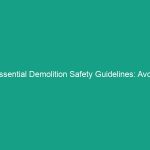Introduction
Good morning team! Today, we’re going to focus on Essential Reporting Incidents Guidelines to Enhance Workplace Safety. This topic is crucial because understanding how to report incidents effectively can significantly improve our overall Safety culture and prevent future accidents. When we talk about Workplace Safety, we mean ensuring that every employee goes home safe and sound at the end of the day. Let’s dig into why reporting incidents is so important and how we can all contribute.
Understanding Essential Reporting Incidents Guidelines
The term Essential Reporting Incidents Guidelines refers to the protocols and Procedures that employees must follow when an incident occurs in the workplace. This includes anything from near misses to accidents that result in injury or damage. Proper reporting ensures that we can analyze incidents, identify trends, and implement preventive measures to enhance Workplace Safety.
Many employees believe that only severe accidents need to be reported, but this misconception can lead to a lack of awareness and increased risks. In reality, all incidents, regardless of their severity, should be documented. This helps us learn and adapt our Safety practices continuously.
Key Hazards, Risks, and Safety Considerations
When it comes to Workplace Safety, understanding the key Hazards and risks associated with incident reporting is vital. Failing to report incidents can result in:
- Increased Risk of Future Incidents: Not addressing the root cause of an incident can lead to repeated occurrences.
- Legal Liabilities: Inadequate reporting can expose the company to legal challenges if an incident escalates.
- Reduced Employee Morale: A culture that undermines safety reporting can lead to distrust among employees.
The consequences of ignoring safety protocols can be severe, impacting not only individual employees but also the entire organization. By recognizing these risks, we can better appreciate the significance of effective incident reporting.
Best Practices, Procedures, & Actionable Advice
Now, let’s discuss some Best Practices for reporting incidents effectively:
1. Immediate Reporting
As soon as an incident occurs, report it to your supervisor or safety officer. Delaying the report can compromise the investigation.
2. Documenting the Incident
When reporting, provide detailed information, including:
- Date and time of the incident
- Location
- People involved
- A description of the incident
- Witnesses
3. Use the Correct Forms
Familiarize yourself with the incident reporting forms used within the organization. Ensure you fill them out completely and accurately.
4. Follow Up
After submitting an incident report, follow up to understand what actions are being taken. This shows that you care about safety and helps keep the issue on the radar.
Real-Life Example
Consider a situation where an employee slips on a wet floor but does not report it because they feel it was not serious. A few days later, another employee slips in the same spot and is injured. If the first incident had been reported, the company could have taken immediate action to address the hazard. This highlights the importance of documenting every incident.
Regulations, Standards, and Compliance
Understanding the Regulations surrounding incident reporting is crucial. Organizations must adhere to Standards set by OSHA (Occupational Safety and Health Administration) and other relevant bodies. Compliance helps protect employees and ensures that the company is taking necessary Precautions to maintain a safe work Environment.
Failing to comply with these regulations can lead to severe penalties and increased risks for employees. Remember, safety is not just a priority; it’s a legal obligation.
Employee Engagement & Discussion
Now that we’ve covered the essentials, let’s engage in a discussion. Here are some questions to consider:
- Have you ever witnessed an incident that was not reported? What happened?
- What challenges do you think might prevent someone from reporting an incident?
- How can we encourage a culture of openness regarding safety reporting?
Feel free to share your thoughts and experiences. Remember, every voice is important when it comes to safety!
Conclusion & Key Takeaways
In conclusion, understanding and adhering to Essential Reporting Incidents Guidelines is vital for enhancing Workplace Safety. Here are the key takeaways:
- Report all incidents immediately, regardless of severity.
- Document details accurately to aid in investigation and Prevention.
- Stay informed about relevant safety regulations and compliance requirements.
- Engage in discussions about safety and encourage a culture of reporting.
By prioritizing safety and adhering to these guidelines, we can create a safer work environment for everyone. Thank you for your attention and commitment to making our workplace safer. Let’s keep the conversation going and support each other in maintaining a culture of safety!


